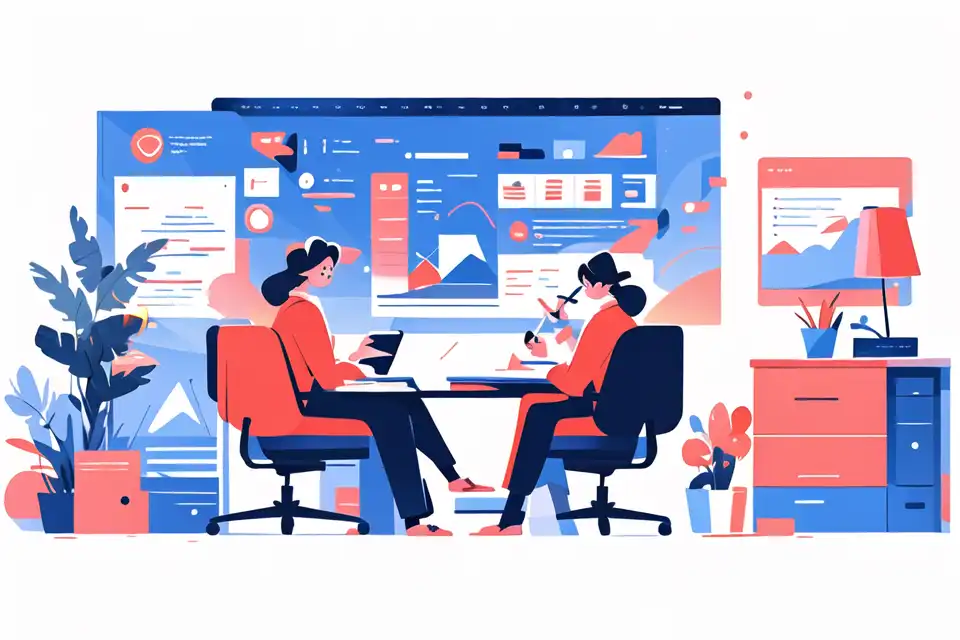Divergent Thinking for Information Technology Teams
Explore divergent thinking for information technology teams, ensuring efficiency and successful project management outcomes.
Try Lark for Free
Before delving into the intricate details of divergent thinking in the context of information technology teams, it's imperative to establish the fundamental importance of creativity and innovation in this domain. Traditionally perceived as a realm driven solely by logic and rationale, IT is increasingly recognizing the value of creativity and non-linear ideation. IT teams operate in a complex and dynamic environment, facing a myriad of challenges that demand innovative and adaptive solutions. Embracing divergent thinking can significantly enhance the agility, creativity, and problem-solving capabilities of IT professionals, thereby inspiring a strategic shift towards innovative approaches.
Leverage Lark for project management within your team.
Understanding divergent thinking
The concept of divergent thinking encompasses the ability to explore multiple possible solutions to a problem, leading to original and varied outcomes. Unlike convergent thinking, which seeks a single, optimal answer, divergent thinking encourages broad exploration and open-ended, unconstrained ideation. Within the context of information technology, divergent thinking empowers teams to approach complex challenges with creativity, flexibility, and a willingness to entertain unconventional ideas. It facilitates the exploration of diverse perspectives, fostering an environment of inclusivity and creativity that is pivotal in the dynamic IT landscape.
Key Features of Divergent Thinking
- Promotes Creativity: Divergent thinking stimulates creative thinking, fueling the generation of innovative solutions that may not be apparent through linear problem-solving approaches.
- Encourages Exploration: It invites individuals to delve into uncharted territories, encouraging the exploration of diverse ideas and perspectives, thus expanding the realm of potential solutions.
- Embraces Ambiguity: Divergent thinking thrives in ambiguous and uncertain situations, where conventional approaches may fall short, enabling IT teams to thrive in complex and rapidly changing environments.
Importance of Divergent Thinking for IT Teams
In the context of information technology teams, divergent thinking holds immense significance. Given the multifaceted and dynamic nature of IT challenges, the ability to approach problems with fresh perspectives and innovative solutions is paramount. Divergent thinking enhances the adaptability and resilience of IT teams, enabling them to navigate technological shifts, anticipate and address emerging issues, and drive sustainable innovation.
Divergent Thinking vs. Convergent Thinking: Understanding the Difference
Convergent thinking focuses on deriving a single, correct solution, often applied in traditional problem-solving methodologies. In contrast, divergent thinking encourages the exploration of multiple possibilities, allowing for a diverse range of potential solutions. While both are valuable, the fluidity and adaptability of divergent thinking hold particular relevance in the dynamic and multifaceted realm of information technology.
Benefits of divergent thinking for information technology teams
Divergent thinking offers a plethora of benefits for information technology teams, augmenting their problem-solving capabilities, fostering innovation, and enhancing collaborative dynamics. Let's delve into the key benefits in detail.
Enhancing Problem-Solving Capabilities
The innate nature of divergent thinking enables IT teams to approach problems holistically and creatively, leading to the development of innovative solutions that are not bound by traditional constraints. By embracing divergent thinking, IT professionals can explore a myriad of inventive approaches, resulting in robust and adaptive problem-solving mechanisms.
Fostering Innovation and Creativity
Innovation lies at the heart of information technology, driving its evolution and propelling advancement. Divergent thinking sparks creativity within IT teams, encouraging them to envision unconventional solutions, disrupt existing paradigms, and leverage new technologies and methodologies. This fosters a culture of innovation, fueling continuous growth and transformation within the IT domain.
Promoting Dynamic and Adaptive Solutions
The dynamic nature of the IT landscape demands solutions that are adaptable and future-proof. Divergent thinking empowers IT teams to embrace flexibility, agility, and adaptability in their problem-solving approaches, enabling them to address evolving challenges with resilience and foresight. By exploring diverse perspectives and ideas, IT professionals can develop solutions that are not only effective in the present but are also primed for future advancements.
Facilitating Agile and Responsive Mindset
Agility is a cornerstone of effective IT operations, enabling teams to respond swiftly to emerging trends, challenges, and opportunities. Divergent thinking instills an agile mindset within IT teams, promoting continuous learning, experimentation, and adaptation. This adaptive stance allows IT professionals to navigate rapid changes and uncertainties with confidence, driving progressive and responsive outcomes.
Improving Collaboration and Teamwork
Divergent thinking fosters a culture of inclusivity, collaboration, and open communication within IT teams. By encouraging diverse viewpoints and novel ideas, IT professionals can collectively harness their strengths, expertise, and creativity to address complex challenges. This collaborative synergy not only enhances problem-solving efficacy but also nurtures a cohesive and empowered team dynamic within the IT domain.
Steps to implement divergent thinking for information technology teams
Implementing divergent thinking within information technology teams requires a strategic approach aimed at fostering a nurturing, innovative environment conducive to creative exploration. The following steps provide a comprehensive framework for integrating divergent thinking into IT team dynamics.
Step 1: Creating a Culture of Exploration and Experimentation
To cultivate divergent thinking within IT teams, it is essential to foster an environment where exploration, experimentation, and unconventional ideation are not only encouraged but celebrated. This can be achieved through the following initiatives:
- Encouraging Open and Inclusive Communication: Establish open channels of communication that enable team members to freely express diverse ideas, perspectives, and innovative concepts without fear of judgment or criticism.
- Promoting Idea Generation Platforms: Implement platforms, such as brainstorming sessions, ideation workshops, and digital collaboration tools, that facilitate the generation and visualization of creative ideas, encouraging active participation from all team members.
Step 2: Embracing Diversity and Inclusivity
The integration of diverse perspectives and experiences is fundamental to the evolution of divergent thinking within information technology teams. Embracing diversity fosters a robust and inclusive environment wherein unconventional insights and approaches can flourish. Key strategies include:
- Leveraging Varied Perspectives and Experiences: Actively seek diverse perspectives and insights from team members encompassing different backgrounds, expertise, and cultural nuances. Encourage inclusive participation, valuing each individual's unique contributions towards divergent thinking.
- Valuing Non-Conventional Approaches: Cultivate a culture that appreciates and acknowledges non-traditional, non-linear approaches to problem-solving, acknowledging the potential for groundbreaking innovation stemming from varied viewpoints.
Step 3: Implementing Design Thinking Techniques
Design thinking acts as a catalyst for creative exploration and problem-solving, aligning seamlessly with the principles of divergent thinking. By integrating design thinking methodologies, IT teams can effectively harness divergent thinking to reimagine solutions and user experiences. Key components include:
- Empathy and User-Centered Ideation: Encourage IT professionals to empathize with end-users, understanding their needs, aspirations, and pain points. This approach inspires innovative ideation centered around enhancing user experiences and addressing real-world challenges.
- Iterative Prototyping and Validation: Embrace iterative prototyping and validation processes that enable the refinement and validation of diverse ideas, fostering an environment where experimentation and learning are integral to the ideation process.
Step 4: Emphasizing Continuous Learning and Adaptation
Divergent thinking thrives in environments that encourage continuous learning, adaptability, and a proactive stance towards embracing change. IT teams can embed this mindset by:
- Encouraging Knowledge Sharing and Cross-Functional Training: Facilitate knowledge-sharing sessions, cross-functional training programs, and skill development initiatives that promote interdisciplinary learning and the exchange of diverse ideas and best practices.
- Embracing Failure as a Stepping Stone for Growth: Cultivate a culture that embraces failure as a natural part of the innovation journey, encouraging IT professionals to view setbacks as learning opportunities that fuel future successes.
Step 5: Cultivating a Supportive and Empowering Environment
Leadership and organizational culture play pivotal roles in nurturing divergent thinking within information technology teams. Fostering an environment that champions creativity, risk-taking, and psychological safety can significantly bolster the integration of divergent thinking. Key initiatives encompass:
- Leadership's Role in Nurturing Divergent Thinking: Leaders should exemplify and advocate a vision that embraces divergent thinking, empowering team members to think creatively, take calculated risks, and challenge the status quo.
- Building Psychological Safety and Risk-Taking Culture: Cultivate an environment where team members feel psychologically safe to express diverse perspectives, challenge norms, and experiment with unconventional ideas without the fear of retribution or censure.
Learn more about Lark Project Management for Teams
Common pitfalls and how to avoid them in information technology teams
Though the integration of divergent thinking can revolutionize problem-solving within information technology teams, certain pitfalls must be acknowledged and mitigated to ensure a seamless transition towards a more innovative mindset.
Pitfall 1: Overemphasis on Efficiency Over Innovation
In the IT domain, efficiency and precision are often prized attributes, leading to a potential overemphasis on optimizing existing processes and systems, thereby stifling innovative ideation. To address this pitfall, IT teams can deploy the following strategies:
- Balancing Operational Excellence with Creative Freedom: Advocate a holistic approach that integrates efficiency with creative exploration, emphasizing the importance of unconventional ideation while maintaining operational excellence.
Pitfall 2: Resistance to Change and Unfamiliar Approaches
Resistance to change is a common challenge encountered when introducing divergent thinking in IT teams. Addressing this resistance necessitates a strategic approach to cultivate acceptance and embrace novel methodologies. Key strategies include:
- Strategies for Overcoming Resistance and Increasing Acceptance: Engage in transparent communication, extensive stakeholder engagement, and tangible demonstrations of the benefits derived from divergent thinking approaches to alleviate resistance and instill confidence in adopting innovative methods.
Pitfall 3: Lack of Clear Communication and Alignment
In the absence of transparent communication and alignment, the integration of divergent thinking can lead to confusion and disjointed efforts within IT teams. To mitigate this challenge, it is imperative to:
- Aligning Organizational Objectives with Divergent Thinking Practices: Ensure that the integration of divergent thinking aligns harmoniously with organizational objectives, fostering a cohesive and purpose-driven approach that yields unified innovative outcomes.
Learn more about Lark Project Management for Teams
Leverage Lark for project management within your team.








